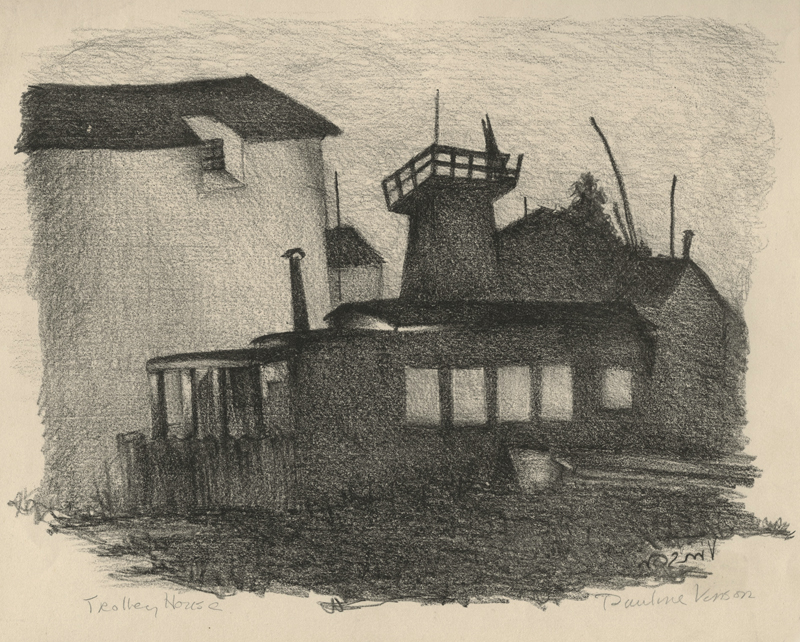Trolley House is a lithograph created about 1937 by American artist Pauline Vinson. It is pencil signed and titled and was printed by Ray Bertrand in an edition of perhaps twenty-eight impressions. Trolley House was published by the California WPA Federal Art Project and is listed in the General Services Administration book WPA Artwork in Non-Federal Repositories. The paper is Rives wove and the image measures 9-3/8 x 12-1/2 inches.
Trolley House depicts a scene from Carville, or Carville-by-the-Sea, or Cartown, a tiny neighborhood located at Ocean Beach in San Francisco’s Sunset District. When the railway company sold it outdated horse-drawn trolley cars for under $20.00, San Franciscans made use of the cars across the city. Colonel Dailey, a friend of mayor Adolph Sutro, used some of the cars to build a coffee shop at Ocean Beach. Other people envisioned the possibilities of these trolley cars and bohemians purchased them and developed a neighborhood of homes, restaurants, and clubhouses. Some cars were stand-alone establishments, and some were stacked on top of each other in creative architectural configurations. The village of trolley cars became an epicenter of San Francisco bohemia. The tenants were from all aspects of society. One car was rented by a judge and another by a ladies’ bicycle club. Another car was owned by San Francisco writers like Jack London, Ina Coolbrith, and George Sterling. Like most low-cost housing and studio spaces artists discover, Carville was short-lived as developers, realtors and the city of San Francisco claimed the land for higher density housing. Most of the street-car homes were destroyed, but some of the shells were built into new homes in the 1930s. There is one last remaining home consisting of street cars, located at 1732 Great Highway. [This information is drawn from an article written by Katie Canales.]
Pauline Eckles Young (née Pauline E. Vinson), painter, printmaker, and illustrator, was born to Sherman and Elsie Eckles Vinson in Orange, California on June 23, 1915. In the 1930 she was living in San Francisco, California, and was employed in the graphics division of the WPA Federal Art Project. Vinson created at least seventeen works for the WPA and WPA Artwork in Non-Federal Repositories published by the U.S. General Services Administration lists fourteen titles and the GSA website lists another three titles.
Vinson also established a career in book illustration, using watercolors to illustrate Festivals in San Francisco (1939), Around the World in San Francisco (1940), and Hilltop Russians in San Francisco (1941). In the early 1940s she moved to New York City to further her career, illustrating children's books for MacMillan Company.
One of Vinson’s lithographs was selected for inclusion in a 1937 exhibition of sixteen WPA prints representing Northern and Southern California at the Booker T. Washington Community Center in San Francisco. She was also included in an exhibition at the De Young Museum, San Francisco, California in 1939, which may have been Frontiers of American Art.
The work of Pauline Vinson is represented in the collections of the Baltimore Museum of Art, Maryland; the Museum of Fine Arts Boston, Massachusetts; the Museum of Art, University of Oregon, Eugene; the Washington County Museum of Fine Arts, Hagerstown, Maryland; the Weisman Art Museum, University of Minnesota, Minneapolis; the Fine Arts Museums of San Francisco, California; the Mulvane Art Museum, Topeka, Kansas; the Krannert Art Museum, University of Illinois, Urbana-Champaign; the National Gallery of Art, Washington, D.C., and the Smithsonian American Museum of Art, Washington, D.C.
Pauline Eckles Vinson Young died in Santa Clara, California on June 22, 1986.



